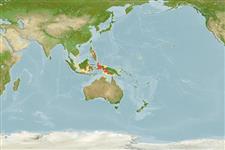>
Eupercaria/misc (Various families in series Eupercaria) >
Labridae (Wrasses)
Etymology: Paracheilinus: Greek, para = the side of + Greek, chaite = hair + Greek, odous = teeth (Ref. 45335); nursalim: Named for Sjamsul and Itjih Nursalim; noun in apposition..
Environment: milieu / climate zone / depth range / distribution range
Écologie
marin récifal; profondeur 5 - 50 m (Ref. 74967), usually 20 - 35 m (Ref. 74967). Tropical
Western Pacific: New Guinea, Indonesia.
Taille / Poids / Âge
Maturity: Lm ? range ? - ? cm
Max length : 5.1 cm SL mâle / non sexé; (Ref. 74967); 2.9 cm SL (female)
Description synthétique
Morphologie | Morphométrie
Épines dorsales (Total): 8 - 9; Rayons mous dorsaux (Total): 11; Épines anales 3; Rayons mous anaux: 8 - 10. This species is distinguished by the following set of characters: pored lateral-line scales 11-16+3-10, often 16+5-7; gill rakers usually 12-13 (sometimes 14-15); body depth 2.9-3.5 in SL; often, 4-6 (rarely 3) dorsal soft rays of males prolonged as narrow, tapering filaments that are erected during courtship; in males, caudal fin strongly lunate, the length 1.6 (1.7-2.4) in SL and caudal concavity 0.8-1.5 in HL; pelvic fins 1.6-1.8 in males and 2.0-2.2 in females, both in HL; live colour of male differs from all other Paracheilinus in having a pair of rectangular blackish patches, one on ventral half of caudal peduncle and adjacent body, and the other, often less distinct, on upper back, below middle of spinous dorsal fin. Similar to P. cyaneus in general appearance; sympatric throughout its known range (Misool, Fak Fak Peninsula, and Triton Bay area). The two species are easily distinguished on the basis of male coloration, particularly that associated with courtship displays (Ref. 74967).
Inhabits semi-sheltered areas, exposed to periodic strong currents; invariably associated with gradual rubble slopes at depths ranging from about 5-50 m or more, but most abundant between about 20 and 35 m. Large aggregations, of about 30 males and several hundred females, were occasionally encountered in only 6 to 10 m at Triton Bay (Ref. 74967).
Life cycle and mating behavior
Maturité | Reproduction | Frai | Œufs | Fécondité | Larves
Oviparous, distinct pairing during breeding (Ref. 205).
Allen, G.R. and M.W. Erdmann, 2008. Paracheilinus nursalim, a new species of flasher wrasse (Perciformes: Labridae) from the Bird's Head Peninsula of western New Guinea with a key to the species of Paracheilinus,. aqua, Int. J. Ichthyol. 13(3-4):179-188. (Ref. 74967)
Statut dans la liste rouge de l'IUCN (Ref. 130435)
Menace pour l'homme
Harmless
Utilisations par l'homme
Plus d'informations
PaysZones FAOÉcosystèmesOccurrencesIntroductionsStocksÉcologieRégime alimentaireÉléments du régime alimentaireConsommation alimentaireRation
Taille/ÂgeCroissanceLongueur-poidsLongueur-longueurFréquences de longueursMorphométrieMorphologieLarvesDynamique des populations larvairesRecrutementAbondanceBRUVS
RéférencesAquacultureProfil d'aquacultureSouchesGénétiqueElectrophoresesHéritabilitéPathologiesTraitementNutrientsMass conversion
CollaborateursImagesStamps, Coins Misc.SonsCiguateraVitesseType de nageSurface branchialeOtolithesCerveauxVision
Outils
Articles particuliers
Télécharger en XML
Sources Internet
Estimates based on models
Preferred temperature (Ref.
123201): 27.9 - 29, mean 28.3 °C (based on 32 cells).
Phylogenetic diversity index (Ref.
82804): PD
50 = 0.5000 [Uniqueness, from 0.5 = low to 2.0 = high].
Bayesian length-weight: a=0.00955 (0.00456 - 0.02002), b=3.06 (2.89 - 3.23), in cm total length, based on LWR estimates for this (Sub)family-body shape (Ref.
93245).
Niveau trophique (Ref.
69278): 3.3 ±0.4 se; based on size and trophs of closest relatives
Résilience (Ref.
120179): Haut, temps minimum de doublement de population inférieur à 15 mois (Preliminary K or Fecundity.).
Fishing Vulnerability (Ref.
59153): Low vulnerability (10 of 100).
Nutrients (Ref.
124155): Calcium = 181 [102, 412] mg/100g; Iron = 1.21 [0.66, 2.41] mg/100g; Protein = 18.1 [15.1, 20.3] %; Omega3 = 0.192 [0.099, 0.360] g/100g; Selenium = 24.2 [11.5, 51.5] μg/100g; VitaminA = 293 [85, 1,131] μg/100g; Zinc = 2.39 [1.48, 3.85] mg/100g (wet weight);
